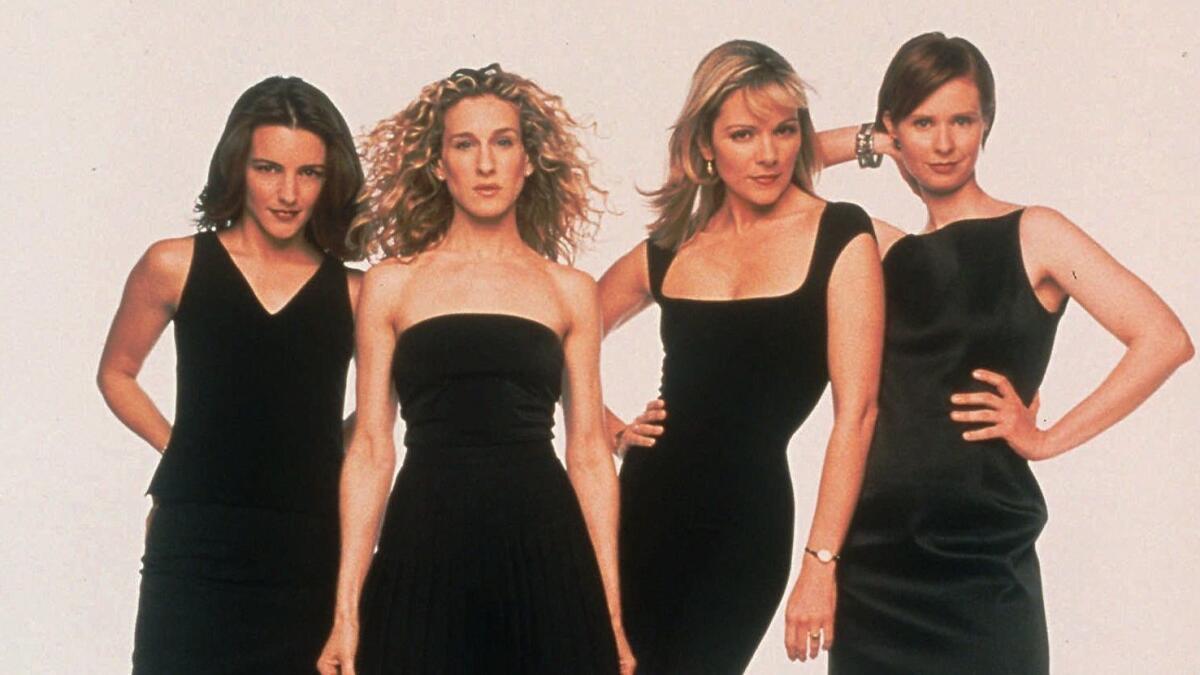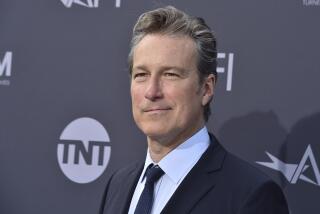From the Archives: Sophisticated approaches to sex in singular eras

- Share via
“Sex and the City” turns 20 today. Below is The Times’ original review of the series from June 5, 1998.
A measure of television’s maturity — not its depravity, as some will insist — is Saturday’s arrival of “Sex and the City,” succeeding “The Larry Sanders Show” as the next great comedy series from HBO.
The same applies to Sunday’s debut of Showtime’s “More Tales of the City,” a pleasing two-night sequel to a controversial “American Playhouse” set in San Francisco of the 1970s. The upfront gayness of that miniseries outraged many conservatives when it aired on PBS four years ago.
Although both cityscapes are sexually blunt and refreshingly counter the rhythms of conventional TV — a smart way to awaken viewers dozing to June’s Muzak of network reruns — they couldn’t be more unalike.
“Sex and the City” is a Via Veneto of late-’90s Manhattan singles culture, sweet jazz blowing in the background as a perfectly cast Sarah Jessica Parker plays Carrie Bradshaw, a self-titled “sexual anthropologist” who writes a New York newspaper column about her own mid-30ish crowd of bed-hopping, hedonistic female night crawlers who are up to here with the attitudes of men passing through their lives. Hence, their laser intent Saturday night on “having sex like men,” which to them means sleeping with someone and feeling nothing afterward.
The double-length hour premiere opens somewhat laboriously, as Carrie and the rest of her great-looking circle — Kim Cattral as the experienced Samantha, Kristin Davis as the more romantic Charlotte and Cynthia Nixon as the hard-edged corporate lawyer, Miranda — initially coalesce into a whiny, male-bashing monolith. Unlike sex, a little bit of the first half hour goes a long way.
Yet the second 30 minutes — examining a male thing for those “giraffes with big breasts” otherwise known as gorgeously svelte female models — is effortlessly urbane, seductively frivolous and majorly witty. As is the third half-hour, in which Carrie and her friends turn in desperation to himbos in their 20s as an alternative to men in their 30s and 40s, providing another resource for Carrie’s observational humor.
Carrie: “Twentysomething guys always know the really important B-people: busboys, bouncers. Plus, they have cute butts.”
The aftermath is not as good as the sex, however. Jolted back to reality the morning after sleeping with one of these infantile hardbodies, Carrie heads for his bathroom only to discover an important item is missing.
Her: “I need toilet paper.”
Him: “I’m using the last of it to make the coffee.”
In other words, “Sex and the City” is as shamelessly superficial as the crowd it memorializes, but so sophisticated in its approach to shallowness that it’s also great fun.
Parker’s faded schoolgirl essence works especially well in the presence of Chris Noth (“Law & Order”) as the older, unattainable “major dreamboat” with whom she keeps colliding. And she walks the walk of grand farce even when taking to the street wrapped decadently in the fur of dead animals.
“Sex and the City” is based on a book by Candace Bushnell. The surprising thing is that the HBO rendering is from Darren Star, who is finally getting in touch with his inner adult after creating the infinitely lesser-brow “Beverly Hills, 90210” and “Melrose Place” on Fox.
On the other hand, a serene mingling of sexual tastes and proclivities, not sexual cynicism, epitomizes Showtime’s “More Tales of the City.” It is the latest progeny of fictional stories about pre-AIDS San Francisco that appeared in a newspaper column written by Armistead Maupin. Later, they were translated into a series of novels titled “Tales of the City” that were adapted for TV.
Most critics adored the boldness. Television some day may look back at “Tales of the City,” as Ray Loynd wrote in The Times in 1994, as “where broadcast television really grew up, where mainstream viewers finally welcomed diverse sexual behavior — straight, gay, young and old — in TV drama.”
Yet one viewer’s diversity is another’s perversity. In granting Maupin’s characters access to the airwaves, PBS zoomed “beyond its mandate and . . . actually leaped aboard the homosexual activism bandwagon,” Robert Knight, cultural studies director for the Family Research Council, charges in “Ratings, Morals and Sex on TV,” an arid new documentary that Showtime is running immediately after “More Tales of the City.”
Knight sounds like he took his own leap and fell on his head. Yet such influential right-wing voices were too numerous and powerful to be resisted by an increasingly conservative public network that still remained substantially on the government dole. As a result, PBS misplaced its backbone and said no when Maupin later came calling with “More Tales of the City.” With no federal big daddies to answer to, pay-cable Showtime said yes.
Not that the wallpapering of gays and homosexual smooching in the sequel is anything approaching the insurrection that the original was seen to be by its critics in pre-”Ellen” 1994, even though “I’m asking you to marry me” is still not something you regularly hear one man ask another on TV.
Home base is still 28 Barbary Lane. Here sits the funky apartment house of Anna Madrigal, the likable exotic played so tenderly again by Olympia Dukakis, and who still views the world through the swirls of her own pot smoke and affectionately regards her gay and straight tenants as her children. It turns out that one of them is.
Still on the premises are Laura Linney as the now wiser former hayseed Mary Ann Singleton, and mopey Mona Ramsey, now played by Nina Siemaszko instead of Chloe Webb, whose sparkle and gift for whimsy are deeply missed. Thomas Gibson is as nasty as ever as closeted bisexual socialite Beauchamp Day, and Barbara Garrick still is in a snit as his pregnant wife, Dede. And waiter Brian Hawkins, played by Whip Hubley, is carrying on binoculars sex with a shadowy figure in a window across the way.
Right away, the straight Mary Ann and gay Michael “Mouse” Tolliver, nicely played by Paul Hopkins, sail off on a cruise together, pursuing separate romances, and Mona is off finding her roots in a Nevada whorehouse operated by Mother Mucca, a gnarled, foul-mouthed, extravagantly goofy desert rat of a madam played with such grandiose flair by Jackie Burroughs that she swipes every scene she’s in.
You find yourself impatiently drumming your fingers here from time to time. “More Tales of the City” initially has a lethargic pace that director Pierre Gang manages to pick up only after Nicholas Wright’s Maupin-inspired script travels a series of hairpin turns, some of which are darkly funny (we even meet a prepubescent hit girl), others quite touching.
Most of all, it’s easy being won over by the warmth of Maupin’s characters, while being ever haunted knowing that the ominous cloud drifting over them is AIDS.
* “Sex and the City” premieres Saturday at 9:45 p.m. The series will be seen Sundays at 9 p.m., beginning June 21. The network has rated it TV-MA (may not be suitable for children under the age of 17).
* The first three parts of “Armistead Maupin’s More Tales of the City” will air from 9 p.m. to midnight on Sunday, with the final three installments following in the same time period on Monday, on Showtime. The network has rated it TV-MA.
More to Read
The complete guide to home viewing
Get Screen Gab for everything about the TV shows and streaming movies everyone’s talking about.
You may occasionally receive promotional content from the Los Angeles Times.






